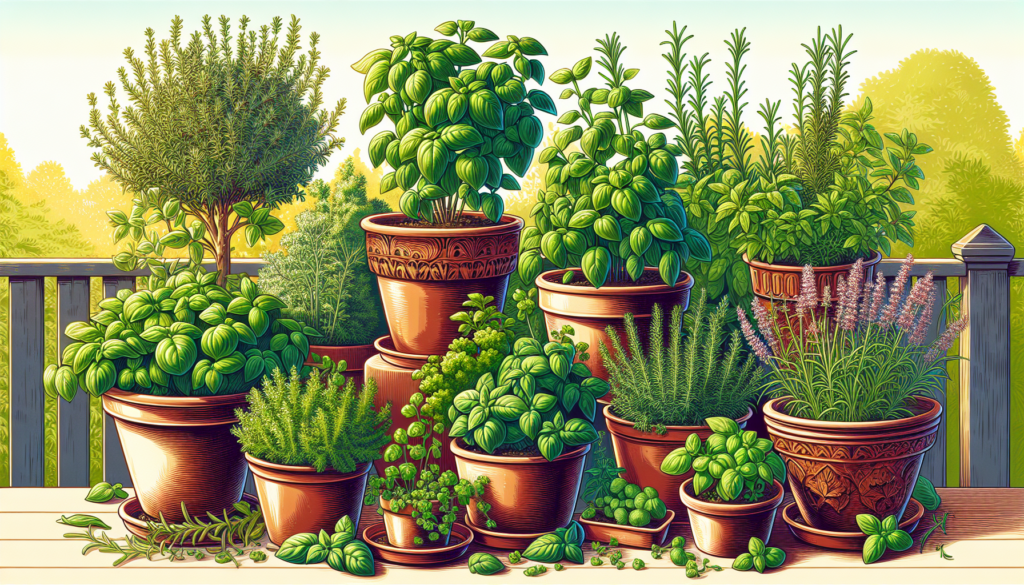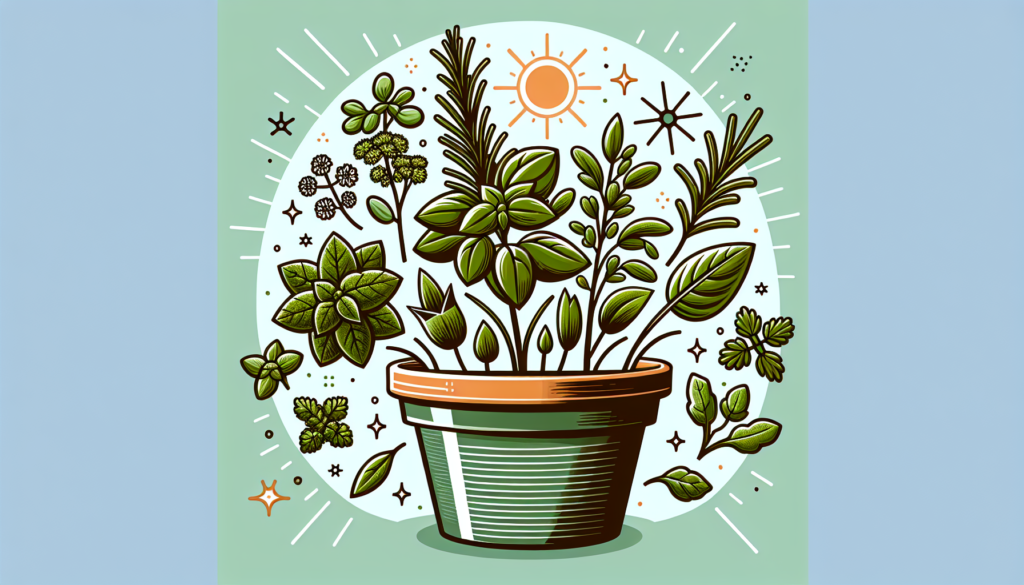If you’re a beginner herb gardener or simply looking to maximize your garden space, you might be wondering which herbs are best suited to be grown together in pots. With limited space, it’s essential to choose herbs that not only thrive in the same growing conditions but also complement each other in terms of flavor and aroma. In this article, we’ll explore some popular combinations of herbs that can coexist harmoniously in pots, providing you with a bountiful and fragrant addition to your culinary adventures.

Complementary Herbs
Basil and Tomatoes
Basil and tomatoes are the perfect culinary companions. They not only share similar growing conditions, but they also enhance each other’s flavors when used together in dishes. The vibrant and sweet taste of basil complements the tangy and juicy flavor of tomatoes, creating a harmonious combination that is commonly found in Italian cuisine.
When growing basil and tomatoes together, make sure to provide them with plenty of sunlight and well-drained soil. They both thrive in warm temperatures, so keep them in a sunny spot or move them indoors during colder months. As the tomatoes grow, the basil leaves can help shade the soil, preventing weed growth and conserving moisture.
Chives and Rosemary
Chives and rosemary are another dynamic duo when it comes to herb gardening. Chives, with their mild onion-like flavor, add a subtle kick to any dish, while rosemary brings a bold and aromatic taste. Together, they create a well-balanced flavor profile that complements a variety of dishes, from roasted meats to creamy soups.
Both chives and rosemary thrive in full sun and well-drained soil. They can be grown in pots or directly in the garden. Chives tend to prefer slightly cooler temperatures, while rosemary thrives in warmer climates. Keep in mind that rosemary is a perennial herb, so make sure to provide it with enough space to grow over time.
Cilantro and Dill
Cilantro and dill, two popular herbs in many cuisines, make a great pairing for both their flavors and growth habits. Cilantro, also known as coriander, has a distinctive citrusy taste that complements the fresh and slightly tangy flavor of dill. Together, they add a burst of freshness to salads, salsas, and sauces.
When growing cilantro and dill together, ensure they have plenty of sunlight and well-drained soil. Cilantro grows quickly and may bolt, or produce flowers and seeds, in hotter temperatures. To prevent this, provide some shade or sow the seeds in succession to have a continuous supply of fresh cilantro. Dill, on the other hand, loves warm and sunny locations, making it an ideal companion for cilantro.
Lemon Balm and Mint
The combination of lemon balm and mint creates a refreshing and invigorating blend that is perfect for teas and cocktails. The lemony scent and flavor of lemon balm pair beautifully with the cool and menthol-like taste of mint, resulting in a harmonious and uplifting experience.
Both lemon balm and mint are relatively easy to grow. They prefer moist but well-drained soil and thrive in partial shade to full sun. However, mint can be quite invasive, so it’s best to grow it in a container to prevent it from taking over your garden. Lemon balm, on the other hand, is a clump-forming herb that won’t spread as aggressively.
Contrasting Herbs
Thyme and Oregano
Thyme and oregano, two classic Mediterranean herbs, may seem similar at first glance, but they offer distinct flavors and aromas that can elevate a dish in contrasting ways. Thyme has a subtle and earthy taste, while oregano boasts a more pungent and robust flavor profile. Combining them adds depth and complexity to various savory dishes.
Both thyme and oregano thrive in well-drained soil and full sun. However, thyme prefers slightly drier conditions, while oregano can tolerate a bit more moisture. Consider planting them side by side and let their foliage intermingle for a visually pleasing and flavorful herb garden.
Sage and Lavender
The combination of sage and lavender creates a sensory experience like no other. Sage, with its strong and earthy aroma, pairs beautifully with the sweet and floral notes of lavender. The contrast between these two herbs can be used to highlight and balance flavors in both savory and sweet dishes.
Sage and lavender share similar growing requirements, making them excellent companions in the garden. They both prefer well-drained soil and full sun but can tolerate some shade. Sage is a perennial herb, while lavender can be either perennial or annual, depending on the variety. Consider planting them in proximity to enjoy their contrasting scents and flavors.
Parsley and Marjoram
Parsley and marjoram, both widely used in Mediterranean and Middle Eastern cuisines, bring different qualities to the table. Parsley’s fresh and grassy taste provides a crisp and bright flavor, while marjoram’s slightly sweeter and spicier profile adds depth to dishes. Together, they create a balance of flavors that enhances a wide range of recipes.
When growing parsley and marjoram together, make sure to provide them with well-drained soil and ample sunlight. Parsley prefers slightly cooler temperatures and partial shade, while marjoram thrives in full sun and warmer climates. By combining these two herbs, you’ll have a versatile duo that can be used in salads, soups, stews, and more.
Tarragon and Fennel
Tarragon and fennel, with their distinct licorice-like flavors, bring a unique twist to any recipe. Tarragon offers a bittersweet and anise-like taste, while fennel provides a sweeter and more pronounced licorice flavor. Together, they create a dynamic combination that can enhance the taste of poultry, seafood, and various sauces.
Both tarragon and fennel thrive in full sun and well-drained soil. Tarragon is a perennial herb that can be grown from cuttings or divisions, while fennel is a hardy perennial that can also be grown from seeds. However, keep in mind that fennel can take up more space due to its size, so ensure you have enough room in your herb garden.
Herbs for Repelling Insects
Lemon Thyme and Lemon Grass
When it comes to repelling insects, lemon thyme and lemon grass are a dynamic duo. Not only do they provide a burst of citrusy scent, but they also have natural insect-repellent properties that help keep unwanted pests at bay. Lemon thyme’s strong aromatic oils and lemon grass’s citronella fragrance create a barrier that insects find unpleasant.
To grow lemon thyme and lemon grass together, ensure they have well-drained soil and plenty of sunlight. Lemon thyme is a low-growing herb that works well as ground cover, while lemon grass can be grown in containers or directly in the garden. By combining these two herbs, you’ll not only have a fragrant herb garden but also a natural defense against insects.
Catnip and Chamomile
Catnip and chamomile are not only beneficial to cats and humans but also to repelling insects. Catnip, a member of the mint family, contains a compound called nepetalactone, which is known to repel mosquitoes. Chamomile, with its delicate flowers and apple-like scent, acts as a natural deterrent for pests like aphids and beetles.
Planting catnip and chamomile together is relatively easy, as they have similar growing requirements. They both prefer well-drained soil and full sun, although chamomile can tolerate some shade. Catnip can be quite invasive, so consider growing it in a container to keep it contained. By doing so, you’ll create a pleasant and insect-repelling garden space.
Lavender and Scented Geraniums
Lavender and scented geraniums are not only visually appealing but are also effective at repelling insects. Lavender’s aromatic oils, combined with the strong scent of scented geraniums, create a natural barrier that deters mosquitoes, flies, and other unwanted pests. Additionally, scented geraniums have been known to repel ticks and ants.
Plant lavender and scented geraniums in well-drained soil and full sun, as both of these herbs thrive in these conditions. Lavender is a perennial herb, while scented geraniums can be annual or perennial, depending on the variety. By incorporating these plants into your garden, you’ll not only enjoy their beauty but also their insect-repelling benefits.
Basil and Mint
Basil and mint, two popular herbs used in various culinary dishes, also offer insect-repelling properties. Both herbs emit strong fragrances that mosquitoes, flies, and other pests find unpleasant. By growing basil and mint together, you’ll not only have a versatile duo for cooking but also a natural defense against insects.
To grow basil and mint together, provide them with well-drained soil and partial to full sun. Mint, in particular, can be quite invasive, so consider growing it in a container to prevent it from spreading and overtaking other plants. By combining basil and mint, you’ll not only have fresh herbs for your recipes but also help repel insects naturally.
Herbs for Attracting Pollinators
Borage and Nasturtium
If attracting pollinators to your garden is your goal, borage and nasturtium are excellent choices. Borage, with its vibrant blue flowers, is a magnet for bees and provides them with a rich source of nectar. Nasturtium, on the other hand, attracts both bees and butterflies with its brightly colored flowers and sweet fragrance.
Plant borage and nasturtium in well-drained soil and full sun to encourage abundant blooming and attract pollinators. Both herbs are annuals and can be easily grown from seeds. By incorporating these pollinator-friendly herbs into your garden, you’ll not only support local ecosystems but also enhance the beauty of your outdoor space.
Lemon Balm and Bee Balm
Lemon balm and bee balm, with their citrusy scents and colorful flowers, are highly attractive to a variety of pollinators, including bees, butterflies, and hummingbirds. Lemon balm’s delicate white flowers and lemony aroma pair well with the vibrant red blooms of bee balm, creating a visually stunning garden that is buzzing with activity.
When growing lemon balm and bee balm together, ensure they have well-drained soil and partial to full sun. Both herbs are perennials and can spread, so provide them with enough space to grow. By attracting pollinators with lemon balm and bee balm, you’ll not only support the local ecosystem but also encourage the pollination of nearby plants.
Lavender and Rosemary
Lavender and rosemary, two beloved herbs known for their aromas and medicinal properties, also attract pollinators with their beautiful flowers. Lavender’s fragrant purple blooms and rosemary’s delicate blue flowers lure bees, butterflies, and other beneficial insects to your garden, ensuring the pollination of nearby plants.
Both lavender and rosemary thrive in well-drained soil and full sun. Lavender is a perennial herb, while rosemary can be either perennial or annual, depending on the variety. By planting these pollinator-friendly herbs in your garden, you’ll not only create a visually appealing space but also promote a healthy and thriving ecosystem.
Sage and Thyme
Sage and thyme, both aromatic culinary herbs, are also attractive to pollinators. Sage’s vibrant purple flowers and thyme’s delicate blossoms provide a source of nectar for bees, butterflies, and other beneficial insects. Their presence in your garden will not only add beauty but also support the delicate balance of nature.
To grow sage and thyme together, provide them with well-drained soil and full sun. Both herbs are perennial and relatively low-maintenance, making them suitable for beginner herb gardeners. By incorporating sage and thyme into your garden, you’ll not only enjoy their culinary uses but also encourage the pollination of nearby plants.

Herb Mixtures for Tea
Mint and Lemon Balm
Mint and lemon balm, both aromatic herbs with a refreshing taste, create a delightful blend when used together in tea. Mint’s cool and invigorating flavor pairs perfectly with the citrusy and uplifting notes of lemon balm. Together, they create a soothing and flavorful tea that can be enjoyed hot or iced.
To make a tea with mint and lemon balm, simply steep a handful of fresh leaves in hot water for a few minutes. You can adjust the proportions according to your preference, adding more mint for a stronger mint flavor or more lemon balm for a brighter citrus taste. Experiment with different ratios to find your perfect blend.
Chamomile and Lavender
Chamomile and lavender, both known for their calming properties, make a perfect combination for a relaxing herbal tea. Chamomile provides a subtle and floral taste, while lavender adds a delicate and soothing aroma. Together, they create a tea that promotes relaxation and helps unwind after a long day.
To make a chamomile and lavender tea, steep dried chamomile flowers and lavender buds in hot water for a few minutes. You can strain the tea or use a tea infuser to remove the herbs before drinking. Add a touch of honey or a squeeze of lemon to enhance the flavors if desired.
Lemon Verbena and Thyme
Lemon verbena and thyme combine to create a tea with a refreshing and citrusy twist. Lemon verbena’s lemony fragrance and thyme’s herbal notes complement each other, resulting in a light and invigorating beverage. This tea is perfect for enjoying during warm summer days or whenever you need a pick-me-up.
To make a lemon verbena and thyme tea, steep a handful of fresh leaves from both herbs in hot water. Let the flavors infuse for a few minutes before straining the herbs. You can add a natural sweetener like agave syrup or stevia if desired. Sip and savor the revitalizing flavors of this delightful tea.
Rosemary and Sage
Rosemary and sage, both robust and aromatic herbs, can be combined to create a flavorful and earthy tea. Rosemary’s resinous and pine-like taste pairs well with the herbal and slightly peppery flavor of sage. This tea is perfect for those seeking a more intense and savory experience.
To make a rosemary and sage tea, steep a few sprigs of fresh rosemary and sage leaves in hot water for several minutes. The longer you steep, the more pronounced the flavors will be. Strain the herbs and sip slowly to fully appreciate the unique taste profile of this fragrant and comforting tea.
Herbs for Italian Cuisine
Basil and Oregano
When it comes to Italian cuisine, basil and oregano are the dynamic duo that can elevate any dish. Basil, with its sweet and slightly peppery flavor, pairs perfectly with the robust and earthy taste of oregano. Together, they create the classic Italian flavor profile that is commonly found in pasta sauces, pizza, and other traditional dishes.
Growing basil and oregano together is relatively straightforward, as they have similar growing requirements. Both herbs prefer well-drained soil and full sun. However, basil is more sensitive to cold temperatures, so it’s best to plant it after the danger of frost has passed. By combining basil and oregano in your herb garden, you’ll have the key ingredients for authentic Italian flavors right at your fingertips.
Thyme and Rosemary
Thyme and rosemary are two versatile herbs that are essential in Italian cuisine. Thyme’s subtle and earthy taste pairs well with the robust and pine-like flavor of rosemary, creating a harmonious blend of aromas and flavors. They are commonly used together in dishes like roasted meats, tomato-based sauces, and herb-infused oils.
Growing thyme and rosemary together is relatively easy, as they prefer similar growing conditions. They both thrive in well-drained soil and full sun. Thyme is a low-growing herb that works well as ground cover, while rosemary can grow into a small shrub. By planting these herbs side by side, you’ll not only enhance your Italian dishes but also enjoy their delightful scents in your herb garden.
Parsley and Marjoram
Parsley and marjoram are staples in Italian cuisine, adding freshness and depth to a variety of dishes. Parsley’s bright and grassy flavor complements the slightly sweeter and spicier profile of marjoram, creating a balanced taste that enhances soups, stews, risottos, and more.
When growing parsley and marjoram together, provide them with well-drained soil and ample sunlight. Parsley prefers slightly cooler temperatures and can tolerate partial shade, while marjoram thrives in full sun and warmer climates. By combining these two herbs, you’ll have the perfect flavor combination for authentic Italian dishes right in your own garden.
Sage and Bay
Sage and bay leaves are aromatic herbs that are frequently used in Italian cooking to add depth and complexity to dishes. Sage’s bold and slightly peppery taste complements the earthy and floral notes of bay leaves, creating a flavorful combination that is commonly found in savory Italian recipes like roasted meats, sauces, and stuffings.
When growing sage and bay, ensure they have well-drained soil and plenty of sunlight. Sage is a perennial herb that can tolerate a variety of growing conditions, while bay leaves come from the Bay Laurel tree and can be grown as a small tree or large shrub. By incorporating these herbs into your herb garden, you’ll have the essential ingredients for authentic Italian flavors at your fingertips.
Herbs for Asian Cuisine
Cilantro and Thai Basil
Cilantro and Thai basil are two herbs commonly found in Asian cuisine, adding a burst of fresh flavors to dishes. Cilantro, with its bright and citrusy taste, pairs well with the peppery and licorice-like flavor of Thai basil. Together, they create a vibrant and aromatic combination that is commonly used in Thai and Vietnamese dishes.
Growing cilantro and Thai basil together is relatively easy, as they have similar growing requirements. They both prefer well-drained soil and thrive in full sun. However, cilantro has a short lifespan and tends to bolt, or go to seed, quickly in hot temperatures. To ensure a continuous supply of fresh cilantro, sow the seeds in succession or provide some shade during the hottest part of the day.
Lemongrass and Kaffir Lime Leaves
Lemongrass and kaffir lime leaves are essential herbs in Southeast Asian cooking, providing a citrusy and aromatic punch to dishes. Lemongrass, with its bright and lemony flavor, pairs well with the distinct and zesty taste of kaffir lime leaves. Together, they create a flavor profile commonly found in Thai, Vietnamese, and Indonesian cuisines.
Growing lemongrass and kaffir lime leaves together requires well-drained soil and full sun. Lemongrass is a tropical perennial that thrives in warm temperatures, while kaffir lime leaves can be grown as a small tree or shrub. By incorporating these herbs into your herb garden, you’ll have the key ingredients for authentic Southeast Asian flavors right at your fingertips.
Mint and Thai Chili
Mint and Thai chili, with their contrasting flavors and heat, are commonly used together in Thai cuisine. Mint’s cool and refreshing taste provides a balance to the fiery and spicy nature of Thai chili. Together, they create a dynamic combination that can elevate dishes like salads, curries, and stir-fries.
Growing mint and Thai chili together is relatively straightforward. Mint prefers well-drained soil and partial shade, while Thai chili thrives in full sun and warm temperatures. By combining these herbs in your herb garden, you’ll not only add a burst of flavor to your dishes but also enhance the authenticity of your Thai culinary creations.
Coriander and Ginger
Coriander, also known as cilantro, and ginger are essential herbs in many Asian cuisines, including Indian, Chinese, and Thai. Coriander’s fresh and citrusy flavor complements the warm and pungent taste of ginger, creating a harmonious combination that adds depth and complexity to a wide range of recipes.
Growing coriander and ginger together requires well-drained soil and partial to full sun. Coriander is an annual herb that tends to bolt quickly, so sowing the seeds in succession can ensure a continuous supply. Ginger, on the other hand, is a tropical plant that requires a longer growing season. By incorporating these herbs into your herb garden, you’ll have the building blocks for authentic Asian flavors right at your fingertips.
Herbs for Mediterranean Cuisine
Parsley and Sage
Parsley and sage are two herbs that play a crucial role in Mediterranean cooking, providing freshness and depth of flavor. Parsley’s bright and grassy taste complements the earthy and slightly peppery flavor of sage, creating a harmonious blend that enhances a variety of dishes, from pasta sauces to roasted vegetables.
When growing parsley and sage together, provide them with well-drained soil and full sun. Parsley is a cool-season annual that can tolerate partial shade, while sage is a perennial herb that thrives in full sun and drier conditions. By combining these herbs in your herb garden, you’ll have the essential ingredients for authentic Mediterranean flavors right at your fingertips.
Rosemary and Thyme
Rosemary and thyme are two iconic herbs in Mediterranean cuisine, known for their robust flavors and aromatic qualities. Rosemary’s resinous and pine-like taste pairs well with the earthy and slight lemony flavor of thyme, creating a combination that is commonly found in dishes like roasted meats, grilled vegetables, and marinades.
Growing rosemary and thyme together is relatively straightforward, as they have similar growing requirements. They both prefer well-drained soil and full sun, although rosemary can tolerate poorer soil conditions. By planting these herbs side by side, you’ll not only enhance your Mediterranean dishes but also enjoy their delightful scents in your herb garden.
Oregano and Basil
Oregano and basil are two herbs that are synonymous with Mediterranean cuisine, adding distinct flavors and aromas to a variety of dishes. Oregano’s robust and slightly bitter taste pairs perfectly with the sweet and peppery flavor of basil, creating a well-rounded flavor profile commonly found in pasta sauces, pizzas, and Mediterranean-style salads.
Growing oregano and basil together is relatively easy, as they have similar growing requirements. They both prefer well-drained soil and full sun. However, oregano is a hardy perennial that can tolerate dry conditions, while basil is an annual herb that requires more consistent watering. By incorporating these herbs into your herb garden, you’ll have the essential ingredients for authentic Mediterranean flavors right at your fingertips.
Marjoram and Fennel
Marjoram and fennel are two herbs that bring unique flavors to Mediterranean cuisine. Marjoram’s sweet and slightly spicy taste complements the subtle licorice-like flavor of fennel, creating a combination that adds depth and complexity to dishes like soups, stews, roasted vegetables, and marinades.
When growing marjoram and fennel together, provide them with well-drained soil and full sun. Marjoram is a perennial herb that prefers slightly cooler temperatures and can tolerate partial shade, while fennel is a hardy perennial that can thrive in a variety of growing conditions. By combining these herbs in your herb garden, you’ll have the essential ingredients for authentic Mediterranean flavors right at your fingertips.
Herbs for Mexican Cuisine
Cilantro and Mexican Oregano
Cilantro and Mexican oregano are two herbs that are heavily used in Mexican cuisine, providing distinctive flavors and aromas. Cilantro’s fresh and citrusy taste pairs well with the robust and slightly bitter flavor of Mexican oregano. This combination is commonly found in salsas, guacamoles, tacos, and other traditional Mexican dishes.
Growing cilantro and Mexican oregano together requires well-drained soil and full sun. Cilantro is a cool-season annual that tends to bolt quickly in hot temperatures, so succession planting or providing some shade can ensure a continuous supply. Mexican oregano is a perennial herb that can tolerate drier conditions. By incorporating these herbs into your herb garden, you’ll have the essential ingredients for authentic Mexican flavors right at your fingertips.
Epazote and Mexican Mint Marigold
Epazote and Mexican mint marigold, also known as Mexican tarragon, are two herbs commonly used in Mexican cuisine for their unique flavors. Epazote’s pungent and slightly citrusy taste complements the anise-like flavor of Mexican mint marigold. This combination is frequently used in dishes like beans, soups, and tamales.
Growing epazote and Mexican mint marigold together requires well-drained soil and full sun. Epazote is an annual herb that can grow quite tall, while Mexican mint marigold is a perennial herb that is known for its vibrant yellow flowers. By incorporating these herbs into your herb garden, you’ll have the essential ingredients for authentic Mexican flavors right at your fingertips.
Mexican Tarragon and Chile Peppers
Mexican tarragon, also known as Mexican mint marigold, and chile peppers are essential ingredients in Mexican cuisine, providing both flavor and heat. Mexican tarragon’s anise-like taste pairs well with the spicy and smoky flavor of chile peppers. This combination adds depth and complexity to dishes like moles, salsas, and Mexican-style stews.
Growing Mexican tarragon and chile peppers together requires well-drained soil and ample sunlight. Mexican tarragon is a perennial herb that thrives in full sun, while chile peppers can be annual or perennial, depending on the variety. By incorporating these herbs into your herb garden, you’ll have the essential ingredients for authentic Mexican flavors right at your fingertips.
Coriander and Mexican Sage
Coriander, also known as cilantro, and Mexican sage are two herbs commonly used in Mexican cuisine, providing distinct flavors to dishes. Coriander’s fresh and citrusy taste pairs well with the earthy and slightly spicy flavor of Mexican sage. This combination is commonly found in salsas, marinades, and various Mexican dishes.
Growing coriander and Mexican sage together requires well-drained soil and full sun. Coriander is a cool-season annual that tends to bolt quickly in hot temperatures, so succession planting or providing some shade can ensure a continuous supply. Mexican sage is a perennial herb that can tolerate drier conditions and is often used for its aromatic qualities. By incorporating these herbs into your herb garden, you’ll have the essential ingredients for authentic Mexican flavors right at your fingertips.
Herbs for Barbecue Flavors
Rosemary and Sage
When it comes to barbecue flavors, rosemary and sage are the perfect herbs to impart a bold and aromatic taste to grilled meats and vegetables. Rosemary’s resinous and pine-like flavor pairs well with the earthy and slightly peppery taste of sage. Together, they create a combination that adds depth and complexity to barbecue dishes.
Growing rosemary and sage together is relatively straightforward, as they have similar growing requirements. They both prefer well-drained soil and full sun. Rosemary is a perennial herb that can tolerate poorer soil conditions, while sage is a perennial that thrives in full sun and drier conditions. By incorporating these herbs into your herb garden, you’ll have the essential ingredients for adding barbecue flavors to your dishes right at your fingertips.
Thyme and Oregano
Thyme and oregano are two versatile herbs that can take your barbecue flavors to the next level. Thyme’s subtle and earthy taste pairs well with the robust and slightly bitter flavor of oregano. Together, they create a combination that adds depth and richness to grilled meats, marinades, and barbecue sauces.
Growing thyme and oregano together is relatively easy, as they have similar growing requirements. They both prefer well-drained soil and full sun. Thyme is a low-growing herb that works well as ground cover, while oregano can grow into a larger plant. By planting these herbs side by side, you’ll not only enhance your barbecue dishes but also enjoy their delightful scents in your herb garden.
Garlic and Cilantro
Garlic and cilantro, with their bold and pungent flavors, are essential herbs for adding depth and complexity to barbecue dishes. Garlic’s strong and savory taste complements the fresh and citrusy flavor of cilantro. Together, they create a combination that adds a burst of flavor to marinades, rubs, and sauces.
Growing garlic and cilantro together is relatively straightforward, as they have similar growing requirements. Both herbs prefer well-drained soil and full sun. Garlic is typically planted in the fall for harvest the following summer, while cilantro is a cool-season annual that can bolt quickly in hot temperatures. By incorporating these herbs into your herb garden, you’ll have the key ingredients for enhancing the flavors of your barbecue dishes right at your fingertips.
Parsley and Marjoram
Parsley and marjoram, with their fresh and mild flavors, are versatile herbs that can bring balance and vibrancy to barbecue dishes. Parsley’s bright and grassy taste complements the slightly sweeter and spicier profile of marjoram. Together, they create a combination that adds freshness and depth to grilled meats, salads, and marinades.
Growing parsley and marjoram together requires well-drained soil and ample sunlight. Parsley is a cool-season annual that can tolerate partial shade, while marjoram is a perennial herb that thrives in full sun and warmer climates. By incorporating these herbs into your herb garden, you’ll have the essential ingredients for enhancing the flavors of your barbecue dishes right at your fingertips.





